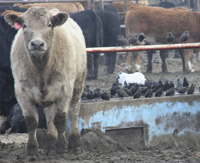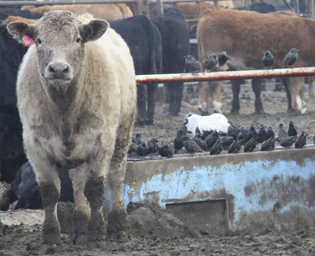
AVMA cattle

USDA APHIS photo
Iowa State University professor Dr. Jan Shearer posited that the enormity of some American cattle operations could compound a crisis, such as an outbreak of foot-and-mouth disease. "How do you euthanize 126,000 cattle, and what do you do with the carcasses?" he asked. To address mass depopulation, Shearer helped author guidelines recently published by the American Veterinary Medical Association.
Eliminating pain and distress in animals in the midst of depopulation may be impossible, but the American Veterinary Medical Association advocates for trying.
The AVMA this month published its first-ever Guidelines for the Depopulation of Animals. The 93-page document — part of a series of reports that include euthanasia and humane slaughter guidelines — contains recommendations for depopulating companion animals; laboratory animals; horses; farm animals; and wildlife. All of the reports address how to end animal life humanely.
Mass depopulation guidance had been included in AVMA euthanasia guidelines until 2013, when the topic was pulled out so it could be given "comprehensive attention," said Dr. Jan Shearer, the dairy extension veterinarian at Iowa State University and chair of the AVMA Panel on Euthanasia.
"I think these guidelines are critically important in the sense that it's what everyone leans on during times of crisis," he said.
Depopulation involves the mass killing of animals to eradicate disease and suffering during large-scale emergencies. The guidelines characterize an emergency situation as one with "a plethora of complicated problems and risks and can include outbreaks of infectious disease and animal-control problems due to a disaster situation and destruction of property."
Asked for examples, Shearer offered the 2001 outbreak of food-and-mouth disease in the United Kingdom, which involved killing more than 6 million cattle and sheep; and the detection in 2017 of highly pathogenic avian influenza virus in U.S. commercial poultry.
Depopulation vs. euthanasia
Source: AVMA, USDA
"I would say they're relatively rare, but we run into these situations from time to time," he said. "There was a bad fire in central Kansas a couple of years ago, and hundreds of cattle got burned so badly, they had to be euthanized. We need strategies for how to euthanize them quickly and efficiently, and then you have to plan for what to do with the carcasses."
Depopulation can be one of the most compassionate things a veterinarian can do for animals, he added.
The guidelines outline AVMA-approved depopulation methods that differ based on factors such as species, resources, population size and how the animals are housed. The guidelines explore how and when to use firearms, gas, immersion and other means for rapid extermination.
There also are suggestions for dealing with emotional burnout, compassion fatigue and other forms of psychological distress that may be experienced by those who are involved in depopulating animals.
Shearer said he's never been involved in depopulation due to a disease outbreak, but he's conducted research for the U.S. Department of Agriculture that involved using a captive bolt stunning gun specifically designed for use in a mass depopulation scenario involving cattle.
The study involved testing tools for the efficient depopulation of a large feedlot, dairy or beef cattle operation. Strategizing for how to quickly mass depopulate to contain an infectious disease outbreak is an important but emotionally difficult task, he said.
"I struggled with this," he said, "and I think anyone who euthanizes a large number of animals does, too. You have to be prepared for psychological problems, and recognize when you may be starting to struggle. It's just not easy."
USDA contributed roughly $36,000 toward development of the AVMA depopulation guidelines. When faced with a crisis or catastrophe, the agency calls for depopulating animals in the most humane and efficient way possible, ideally within 24 hours.
"You have to kill large numbers of animals, and you have to do it rapidly and sometimes in ways that may not constitute euthanasia," Shearer said. "The reality is, that's always going to be difficult."